
I looked forward to seeing San Gimignano again. It's called the Italian
"Rothenburg ob der Tauber" (if that tells you anything). Well, meanwhile
I have been to the German town Rothenburg, but I don't think you can
match both towns. The medieval Italian town is so much more different, more
original than the half-timbered Rothenburg.
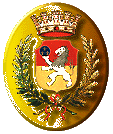 Amid the hills of Tuscany, behind olive- and cypress groves and behind
the many grape wines the town of San Gimignano is peering out. It's the
best preserved medieval town of Tuscany but from its former 72 towers
just 14 remain. I know we all remember New York's Twin Towers but
did you know that they had their model here, in this small Italian town
that is about 1000 years old?
Amid the hills of Tuscany, behind olive- and cypress groves and behind
the many grape wines the town of San Gimignano is peering out. It's the
best preserved medieval town of Tuscany but from its former 72 towers
just 14 remain. I know we all remember New York's Twin Towers but
did you know that they had their model here, in this small Italian town
that is about 1000 years old?
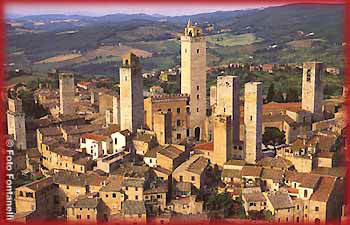 San Gimignano rises on a hill (334m high) dominating the Elsa Valley
with its towers. Once the seat of a small Etruscan village of the
Hellenistic period (200-300 BC) it began its life as a town in the 10th
century taking its name from the Holy Bishop of Modena, St. Gimignano,
who is said to have saved the village from the barbarian hordes. The
town increased in wealth and developed greatly during the Middle Ages
thanks to the "Via Francigena" the trading and pilgrim's route that
crossed it. Such prosperity lead to the flourishing of works of art to
adorn the churches and monasteries. In 1199 it became a free
municipality and fought against the Bishops of Volterra and the
surrounding municipalities. Due to internal power struggles it
eventually divided into two factions one headed by the Ardinghelli
family (Guelphs) and the other by the Salvucci family (Ghibelline). On
the 8th May 1300 Dante Alighieri came to San Gimignano as the Ambassador
of the Guelph League in Tuscany.
San Gimignano rises on a hill (334m high) dominating the Elsa Valley
with its towers. Once the seat of a small Etruscan village of the
Hellenistic period (200-300 BC) it began its life as a town in the 10th
century taking its name from the Holy Bishop of Modena, St. Gimignano,
who is said to have saved the village from the barbarian hordes. The
town increased in wealth and developed greatly during the Middle Ages
thanks to the "Via Francigena" the trading and pilgrim's route that
crossed it. Such prosperity lead to the flourishing of works of art to
adorn the churches and monasteries. In 1199 it became a free
municipality and fought against the Bishops of Volterra and the
surrounding municipalities. Due to internal power struggles it
eventually divided into two factions one headed by the Ardinghelli
family (Guelphs) and the other by the Salvucci family (Ghibelline). On
the 8th May 1300 Dante Alighieri came to San Gimignano as the Ambassador
of the Guelph League in Tuscany.

It's pleasantly fresh here high above, the air is clean. Citadel-like,
ungainly threatening towers with loophole windows. In fog-
and rainy weather the town has to be bloodcurdling - or just simply
unarrested romantic, just as of the psyche of the watcher. But also with
sunshine you will meet in those narrow alleys, where the houses are
clashing above you, the shadow of your own frights: Hired assassins
at the entrance to a back yard. Iron rattles in a duel.
Hot pitch splashes upon the street. A pointed cry from the devil's tower:
a lost soul goes to hell.
The rooms in those towers were small and had to be shared with grocery's
supply and animals. They were connected with outside-ladders which could
be pulled in when danger was near. The quarrels and fights between the
parties of the Guelphs and the Ghibelline were heavy here in San
Gimignano. Pope contra Emperor. The adherants of both tried to erase each
other. When one party had gained a victory, the tower of the enemy would
destroyed.
Through the narrow mean street rolls the stream of tourists. Upon it
once pilgrims, travellers and merchants drove until Florence. Tiny
shops, over boarding with displays accompanied our way. Everywhere
basket makers, Majolica works, richly decorated mirrors, kitsch and
art close together. There are yards, flanked with pergolas, with drinking
water springs and planted with buckets of exotic plants.
And then a broad place opened up: the place of the cistern well. Each
palazzo looks different, brown natural stone and brick stone, dainty,
Pisan arcs, Arabic-steep windows, Florentine overhang-roofs. Palazzo
Lupi with its devil's tower is towering above each of them. There they held
prisoners in dungeons. Amid the place a stone cistern, over 700 years
old. I don't know if there's still water in it for it's locked with a
plate.
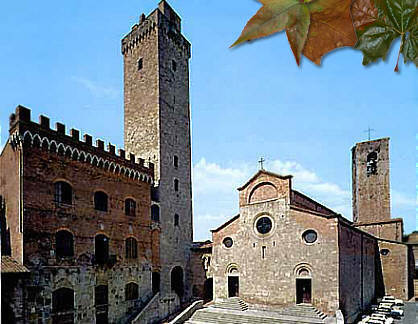 Just a few meters away from these sun flooded places is the loggia where
old men meet for a Saturday's chat. We arrived here at the place of the
cathedral. Actually it's not a cathedral because the town isn't a
bishop's place anymore so the people call the church collegiata. It has
a plain, Romanic, red facade and inside spreads a magic mood under a
blue-golden star's firmament. If you want to see the freschi you have to
make illuminazione (that's usually a small automat where you put money
in it) and soon you'll see again a fibula of pictures for the ones unable
to read (which was of course common for the middle ages). Everything's
there: God, the creator, Adam and Eve, the snake, archangel Gabriel,
Moses, Noah, Mary and Joseph, the massacre of the innocents... and so
further and so forth. But one tale strikes me really, the tale of Job,
who was really proven by God. Told is about the enormous grief that came
over poor Job: the loss of his whole possession, then of his children
and family, at least he's getting ill. Job - always lead a
godfearing life - doesn't understand the reason for his pain. All
his friend's pious words and attempts to explain don't help. He
contacted God himself with complaint and accusation, cries for help and
anger, asking and suppliant. Finally Job realizes his own sinfulness
and God's brilliant creative power, who has marked as lord of
history-life the life of humankind. He doesn't receive an answer to his
fervent question "Why?", but in the end he acknowledged despite all or
just because this that God is the Lord and Job gets everything
new.
Just a few meters away from these sun flooded places is the loggia where
old men meet for a Saturday's chat. We arrived here at the place of the
cathedral. Actually it's not a cathedral because the town isn't a
bishop's place anymore so the people call the church collegiata. It has
a plain, Romanic, red facade and inside spreads a magic mood under a
blue-golden star's firmament. If you want to see the freschi you have to
make illuminazione (that's usually a small automat where you put money
in it) and soon you'll see again a fibula of pictures for the ones unable
to read (which was of course common for the middle ages). Everything's
there: God, the creator, Adam and Eve, the snake, archangel Gabriel,
Moses, Noah, Mary and Joseph, the massacre of the innocents... and so
further and so forth. But one tale strikes me really, the tale of Job,
who was really proven by God. Told is about the enormous grief that came
over poor Job: the loss of his whole possession, then of his children
and family, at least he's getting ill. Job - always lead a
godfearing life - doesn't understand the reason for his pain. All
his friend's pious words and attempts to explain don't help. He
contacted God himself with complaint and accusation, cries for help and
anger, asking and suppliant. Finally Job realizes his own sinfulness
and God's brilliant creative power, who has marked as lord of
history-life the life of humankind. He doesn't receive an answer to his
fervent question "Why?", but in the end he acknowledged despite all or
just because this that God is the Lord and Job gets everything
new.
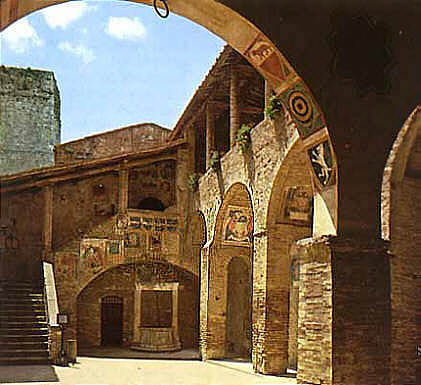 You see, as the century progressed the rivalries between the town's
noble families became bitterer, and the economy gradually soured. The
great plague of 1348 killed close to 75 % of San Gimignano's 13.000
inhabitants and the town collapsed; left without any other options the
town Council begged to enter under Florence's wing.
You see, as the century progressed the rivalries between the town's
noble families became bitterer, and the economy gradually soured. The
great plague of 1348 killed close to 75 % of San Gimignano's 13.000
inhabitants and the town collapsed; left without any other options the
town Council begged to enter under Florence's wing.
The Florentines accepted the offer the following year and San
Gimignano's long decline began. Several panels of the Old Testament
fresco cycle painted in the cathedral in 1361 show Job stoically
watching his house collapse on his sons and daughters while the Devil
kills his flocks; they undoubtedly reflect the unhappiness of the people
with their lot. Not much had changed by 1391, when Taddeo di Bartolo
painted a Last Judgment in which the horrifying torments of the sinners
in hell contrast oddly with a subdued, joyless vision of paradise.
On the right side is situated the praised chapel of the Saint Fina. It's
freshly restored and can be watched after small entrance fee. Completely
painted with freschi by Domenico Ghirlandaio (a Florentine painter in
whose workshop Michelangelo got his first education) it's a real little
gem (1470). Saint Fina btw, is the town's saint on whose day of
death the violets started to bloom on each tower. She was the daughter
of poor people who hadn't themselves got enough to eat but she was
always giving from it to the poor. She suffered sickness and pain and
lead a monastic life until she died aged only (or perhaps 'after')
15 years. Her last place she found in this chapel.

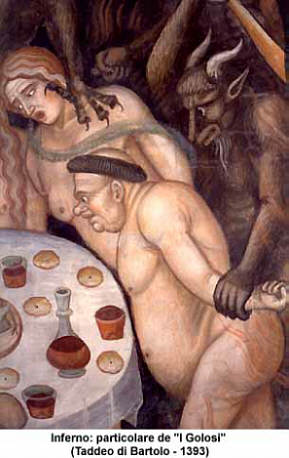
When you're out of the Collegiata turn sharply right and enter the
gangway to the yard of the town hall. Also here's a cistern, and each
afternoon will play a harp-player who sings medieval songs because the
sound is brilliant here. There's a
hidden fresco on one wall, it's Ghirlandaio's "Annunciation", and under it a
baptismal font. If you look at it closer you'll see the very modern interior
of Mary's room. The bookshelf and the standard lamp will be familiar. Both
are protected by iron fence. But on the backside of this yard opens a
way to another yard which is called today the "chapel of the judge man".
The freschi are by Sodoma, showing how Saint Ivone administers justice,
who ignores the rich and noble people trying to bribe
him. The inscription says: "Humans have to atone for their crimes. You,
truth, bring lie to silence." From this yard, painted with the coat of
arms of the Tuscany Union leads a beautiful, covered staircase up to
the museum of the Town Hall. There are works from Tuscan masters and
some funny and very surprising erotic tales (well, for straights)
directly in the chamber of the podesta.
If you examine the facade of the Town Hall closely you'll detect plates
and things are missing. Napoleon's troops have broken out coat of arms
and hung them into their own museums. San Gimignano tries until today to
get back those pieces, in vain.
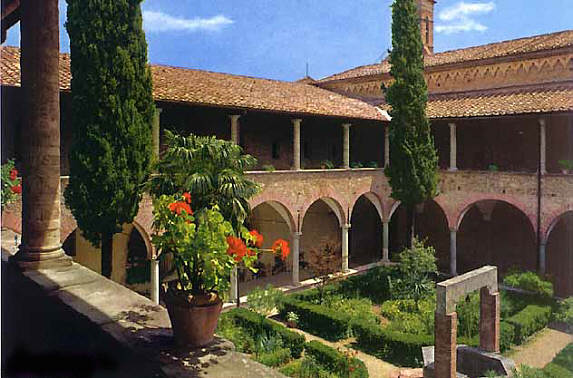 The church of Sant Agostino shouldn't be missed for its splendid
freschi and for the really beautiful cloister. You can go through
the former Franciscan monastery which is today an Enoteca where you
can test and buy wine (mostly the very good Vernaccia that grows around
this town), but you're also allowed to go further through the shop and
look from a terrace into the country. You'll also have a fine view onto
the towers of the town.
The church of Sant Agostino shouldn't be missed for its splendid
freschi and for the really beautiful cloister. You can go through
the former Franciscan monastery which is today an Enoteca where you
can test and buy wine (mostly the very good Vernaccia that grows around
this town), but you're also allowed to go further through the shop and
look from a terrace into the country. You'll also have a fine view onto
the towers of the town.
Or you can visit one of the many shops for alabaster-handiwork. Or enter one
of the many butcher's that eludes us with stuffed wild boar in
front of their doors. It means that they are selling sausages from boar
(a really well-tasting speciality).
You could eat them somewhere outside the town, between the hills, next
to an old farmer's house with ancient olive trees, overlooking a last
time the town. Perched on a hill with its towers thrown into sharp
relief by the deep green mountains behind it, San Gimignano looks like a
town plucked from a fairy tale and set into the Tuscan countryside.
Silence. Cicada's chirp and bird's twittering. You breathe and look.
Melancholy lies over the country. It's a perfect symbiosis of human and
nature, this time a nature made from human's hand.
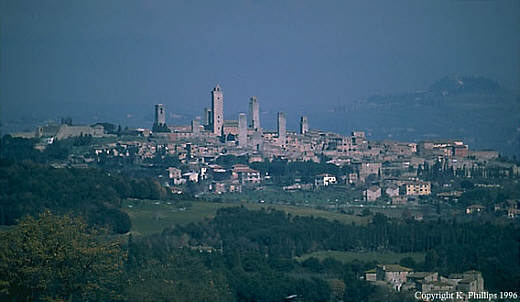 In the car again we drove through Colle Val d'Elsa, a valley the little
river Elsa is passing, above it the medieval walls of this town,
birthplace of Arnolfo di Cambio (architect of the Florentine Cathedral).
Over steep serpentines we drove amid the area of the Chianti, the Gallo
Nero. My eyes losing itself in the soft, silver-green landscape, here
and there towered over with gloomy cypresses.
In the car again we drove through Colle Val d'Elsa, a valley the little
river Elsa is passing, above it the medieval walls of this town,
birthplace of Arnolfo di Cambio (architect of the Florentine Cathedral).
Over steep serpentines we drove amid the area of the Chianti, the Gallo
Nero. My eyes losing itself in the soft, silver-green landscape, here
and there towered over with gloomy cypresses.
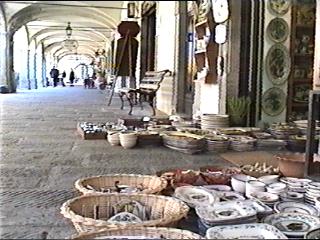
Vineyards over vineyards, Tavernas, Enotecas, villas, apple
plantings. Famous places passing by, finally Greve. It's Flower's
market today. The merchants unloaded hundreds of bowls, nameless for me.
Orange- and lemon trees, laurel and palms. Either you stay here for some
time or drive along until you'll reach Arezzo.
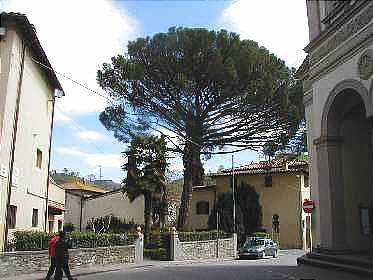


 San Gimignano rises on a hill (334m high) dominating the Elsa Valley
with its towers. Once the seat of a small Etruscan village of the
Hellenistic period (200-300 BC) it began its life as a town in the 10th
century taking its name from the Holy Bishop of Modena, St. Gimignano,
who is said to have saved the village from the barbarian hordes. The
town increased in wealth and developed greatly during the Middle Ages
thanks to the "Via Francigena" the trading and pilgrim's route that
crossed it. Such prosperity lead to the flourishing of works of art to
adorn the churches and monasteries. In 1199 it became a free
municipality and fought against the Bishops of Volterra and the
surrounding municipalities. Due to internal power struggles it
eventually divided into two factions one headed by the Ardinghelli
family (Guelphs) and the other by the Salvucci family (Ghibelline). On
the 8th May 1300 Dante Alighieri came to San Gimignano as the Ambassador
of the Guelph League in Tuscany.
San Gimignano rises on a hill (334m high) dominating the Elsa Valley
with its towers. Once the seat of a small Etruscan village of the
Hellenistic period (200-300 BC) it began its life as a town in the 10th
century taking its name from the Holy Bishop of Modena, St. Gimignano,
who is said to have saved the village from the barbarian hordes. The
town increased in wealth and developed greatly during the Middle Ages
thanks to the "Via Francigena" the trading and pilgrim's route that
crossed it. Such prosperity lead to the flourishing of works of art to
adorn the churches and monasteries. In 1199 it became a free
municipality and fought against the Bishops of Volterra and the
surrounding municipalities. Due to internal power struggles it
eventually divided into two factions one headed by the Ardinghelli
family (Guelphs) and the other by the Salvucci family (Ghibelline). On
the 8th May 1300 Dante Alighieri came to San Gimignano as the Ambassador
of the Guelph League in Tuscany.

 Amid the hills of Tuscany, behind olive- and cypress groves and behind
the many grape wines the town of San Gimignano is peering out. It's the
best preserved medieval town of Tuscany but from its former 72 towers
just 14 remain. I know we all remember New York's Twin Towers but
did you know that they had their model here, in this small Italian town
that is about 1000 years old?
Amid the hills of Tuscany, behind olive- and cypress groves and behind
the many grape wines the town of San Gimignano is peering out. It's the
best preserved medieval town of Tuscany but from its former 72 towers
just 14 remain. I know we all remember New York's Twin Towers but
did you know that they had their model here, in this small Italian town
that is about 1000 years old?

 Just a few meters away from these sun flooded places is the loggia where
old men meet for a Saturday's chat. We arrived here at the place of the
cathedral. Actually it's not a cathedral because the town isn't a
bishop's place anymore so the people call the church collegiata. It has
a plain, Romanic, red facade and inside spreads a magic mood under a
blue-golden star's firmament. If you want to see the freschi you have to
make illuminazione (that's usually a small automat where you put money
in it) and soon you'll see again a fibula of pictures for the ones unable
to read (which was of course common for the middle ages). Everything's
there: God, the creator, Adam and Eve, the snake, archangel Gabriel,
Moses, Noah, Mary and Joseph, the massacre of the innocents... and so
further and so forth. But one tale strikes me really, the tale of Job,
who was really proven by God. Told is about the enormous grief that came
over poor Job: the loss of his whole possession, then of his children
and family, at least he's getting ill. Job - always lead a
godfearing life - doesn't understand the reason for his pain. All
his friend's pious words and attempts to explain don't help. He
contacted God himself with complaint and accusation, cries for help and
anger, asking and suppliant. Finally Job realizes his own sinfulness
and God's brilliant creative power, who has marked as lord of
history-life the life of humankind. He doesn't receive an answer to his
fervent question "Why?", but in the end he acknowledged despite all or
just because this that God is the Lord and Job gets everything
new.
Just a few meters away from these sun flooded places is the loggia where
old men meet for a Saturday's chat. We arrived here at the place of the
cathedral. Actually it's not a cathedral because the town isn't a
bishop's place anymore so the people call the church collegiata. It has
a plain, Romanic, red facade and inside spreads a magic mood under a
blue-golden star's firmament. If you want to see the freschi you have to
make illuminazione (that's usually a small automat where you put money
in it) and soon you'll see again a fibula of pictures for the ones unable
to read (which was of course common for the middle ages). Everything's
there: God, the creator, Adam and Eve, the snake, archangel Gabriel,
Moses, Noah, Mary and Joseph, the massacre of the innocents... and so
further and so forth. But one tale strikes me really, the tale of Job,
who was really proven by God. Told is about the enormous grief that came
over poor Job: the loss of his whole possession, then of his children
and family, at least he's getting ill. Job - always lead a
godfearing life - doesn't understand the reason for his pain. All
his friend's pious words and attempts to explain don't help. He
contacted God himself with complaint and accusation, cries for help and
anger, asking and suppliant. Finally Job realizes his own sinfulness
and God's brilliant creative power, who has marked as lord of
history-life the life of humankind. He doesn't receive an answer to his
fervent question "Why?", but in the end he acknowledged despite all or
just because this that God is the Lord and Job gets everything
new.
 You see, as the century progressed the rivalries between the town's
noble families became bitterer, and the economy gradually soured. The
great plague of 1348 killed close to 75 % of San Gimignano's 13.000
inhabitants and the town collapsed; left without any other options the
town Council begged to enter under Florence's wing.
You see, as the century progressed the rivalries between the town's
noble families became bitterer, and the economy gradually soured. The
great plague of 1348 killed close to 75 % of San Gimignano's 13.000
inhabitants and the town collapsed; left without any other options the
town Council begged to enter under Florence's wing.


 The church of Sant Agostino shouldn't be missed for its splendid
freschi and for the really beautiful cloister. You can go through
the former Franciscan monastery which is today an Enoteca where you
can test and buy wine (mostly the very good Vernaccia that grows around
this town), but you're also allowed to go further through the shop and
look from a terrace into the country. You'll also have a fine view onto
the towers of the town.
The church of Sant Agostino shouldn't be missed for its splendid
freschi and for the really beautiful cloister. You can go through
the former Franciscan monastery which is today an Enoteca where you
can test and buy wine (mostly the very good Vernaccia that grows around
this town), but you're also allowed to go further through the shop and
look from a terrace into the country. You'll also have a fine view onto
the towers of the town.
 In the car again we drove through Colle Val d'Elsa, a valley the little
river Elsa is passing, above it the medieval walls of this town,
birthplace of Arnolfo di Cambio (architect of the Florentine Cathedral).
Over steep serpentines we drove amid the area of the Chianti, the Gallo
Nero. My eyes losing itself in the soft, silver-green landscape, here
and there towered over with gloomy cypresses.
In the car again we drove through Colle Val d'Elsa, a valley the little
river Elsa is passing, above it the medieval walls of this town,
birthplace of Arnolfo di Cambio (architect of the Florentine Cathedral).
Over steep serpentines we drove amid the area of the Chianti, the Gallo
Nero. My eyes losing itself in the soft, silver-green landscape, here
and there towered over with gloomy cypresses.



